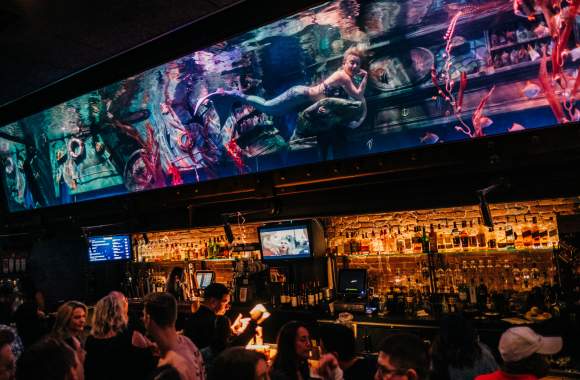an Diego’s nightlife scene is right up there with the best in the country. With its vibrant array of nightclubs, bars and lounges, the city has something for everyone who’s looking for a fun night out. From bottle service to guest DJ appearances, in Downtown and beyond, San Diego’s nightlife sizzles year-round. Keep reading to discover the hottest spots where the parties don’t stop!
Where: 435 Fifth Ave., San Diego, CA 92101
As part of Downtown San Diego’s elegant Pendry Hotel, Oxford Social Club hosts guest DJs and celebrities on the regular. Nestled beneath the illustrious hotel, Oxford offers guests an intimate setting where they can spend the evening sipping cocktails and dancing to the hottest beats. Among the big names seem here have been Jeezy, Wiz Khalifa and Wacka Flocka, not to mention Snoop Dogg, Lebron James and Sofia Vergara
Where: 454 Sixth Ave., San Diego, CA 92101
San Diego nightclub aficionados know that first, there was Stingaree. Then, there was Omnia. And now, there’s NOVA, which opened in the Gaslamp Quarter in 2022. The hotspot, which is operated by Insomniac — an entertainment and nightlife group responsible for the famed Electric Daisy Carnival in Las Vegas, among other events — plays host to such major EDM acts as deadmau5, Tiesto, Diplo and Steve Aoki. The 22,000-square-foot, indoor/outdoor spot is in a prime spot in the Gaslamp at the corner of Sixth and Island Avenues.
Where: 615 Broadway, San Diego, CA 92101
Parked at the corner of Broadway and Sixth Avenue in Downtown San Diego, Parq Nightclub has been a mainstay on the San Diego nightlife scene since opening in 2014. In the years since, Parq has made a name for itself as a must-visit for those looking for a night out on the town. Besides playing host to parties for such major San Diego events as Comic-Con International: San Diego, Parq has also seen big names like 50 Cent, Geazy, YG and Ty Dolla Sign grace its stage. True to its motto, Parq invites San Diegans to #comeplay every Friday and Saturday night.
Where: 536 Market St., San Diego, CA 92101
Under the umbrella of RMD Group, a powerhouse San Diego hospitality group, Side Bar has been described as an “intimate boutique nightclub and lounge” nestled right in the heart of the Gaslamp Quarter. Side Bar has been going strong since 2003, making it one of San Diego’s longest-running clubs. Spanning 4,000 square feet and featuring an elevated DJ booth, Side Bar is known for hosting themed events and bringing in talent like Chantel Jeffries, Sam Blacky and Brody Jenner.
Where: 672 Fifth Ave., San Diego, CA 92101
The lines for Toro in the Gaslamp Quarter regularly stretch around the block, so you know the vibes are immaculate and the energy is on point. Toro is a one-stop-shop for reggaeton/EDM/Top 40 beats, upscale Mexican cantina-style food, unique cocktails and eye-catching lighting effects. The two-level venue regularly features guest sets from touring DJs, plus industry and event specials. Check out their Instagram page for deals on entry, drinks, bottle service and more.
Where: 4325 Ocean Blvd., San Diego, CA 92109
By day, Waterbar is a chic seafood restaurant perched right on the ocean in Pacific Beach. But by night, the beats get louder and the drinks start flowing. Waterbar boasts a more casual club vibe than ones you might find in the Gaslamp, but that’s what makes it shine. Costumed club employees get the party started (think a plush bald eagle rocking out on Fourth of July weekend), and with wide-open windows and ocean views, it doesn’t get more San Diego than this.
Where: 2028 Hancock St., San Diego, CA 92110
Tucked deep into Mission Hills is this hidden gem revered by electronic-music fans. Spin is described as “San Diego’s underground art and music venue, here to unite the community in an immersive, inclusive and intimate experience like no other.” Underground is the key here, as Spin brings in EDM acts who may be lesser-known or on the brink of stardom. The nightclub spans three floors and offers bottle service for those who want to go all-out. The nightclub also regularly hosts acts through FNGRS CRSSD, an offshoot of San Diego’s famous CRSSD Fest, a festival celebrating EDM and house music.














 Good for:
Good for: Good for:
Good for: Universal Studios Hollywood in Los AngelesUnited States of America
Universal Studios Hollywood in Los AngelesUnited States of America TCL Chinese Theatre in Los AngelesUnited States of America
TCL Chinese Theatre in Los AngelesUnited States of America 11 Best Museums in Los AngelesUnited States of America
11 Best Museums in Los AngelesUnited States of America Good for:
Good for: Good for:
Good for: Good for:
Good for: Good for:
Good for: Good for:
Good for: Good for:
Good for: Good for:
Good for: Good for:
Good for: